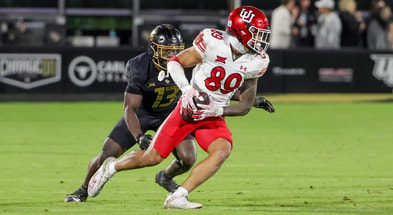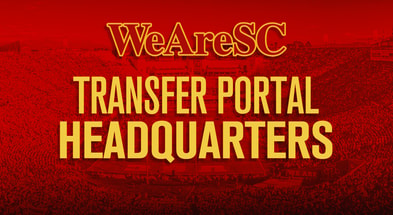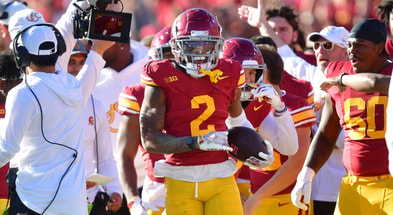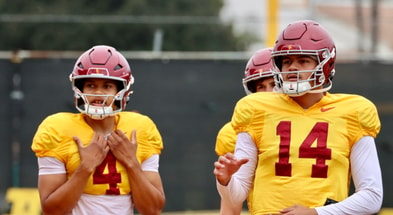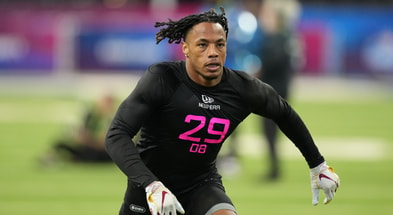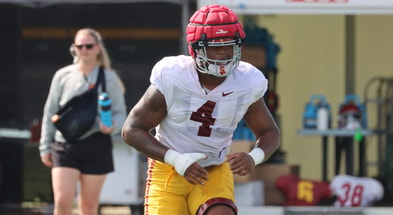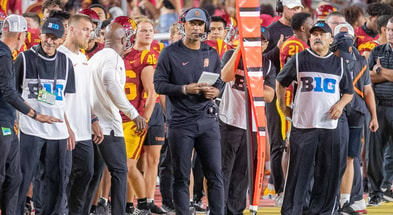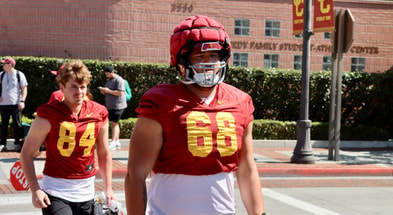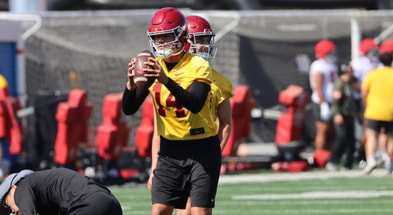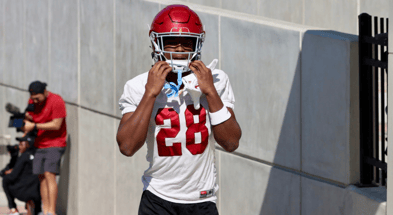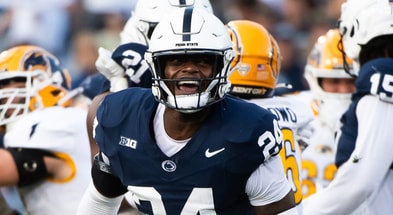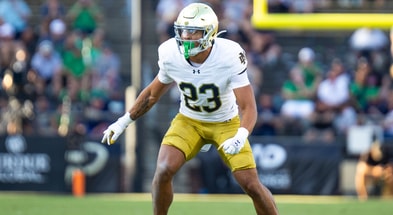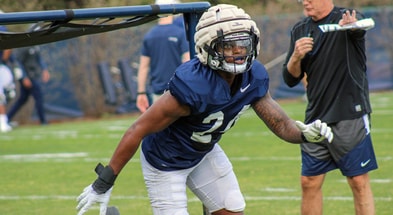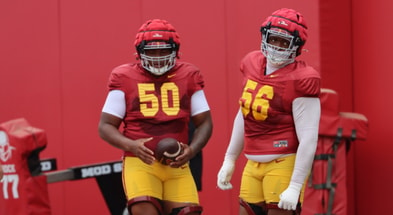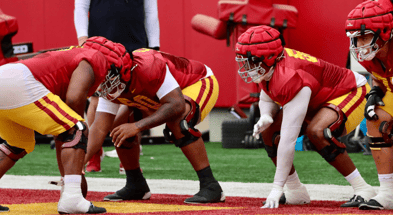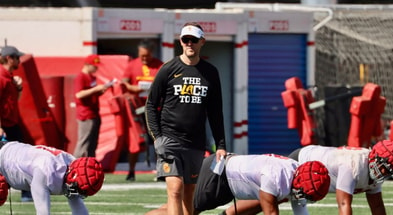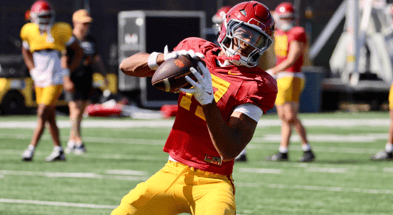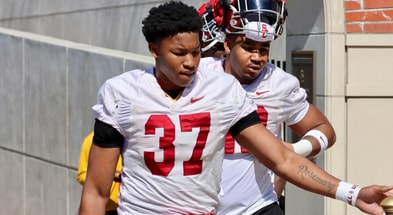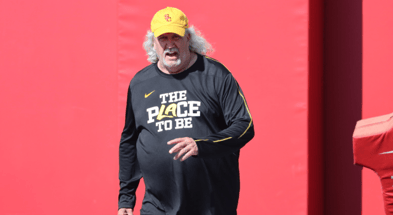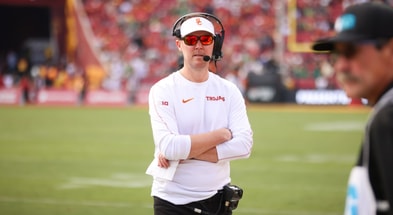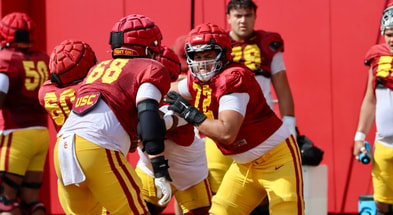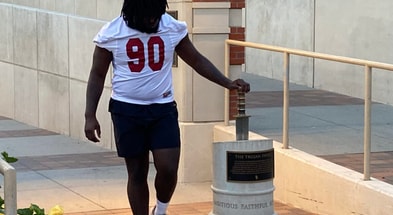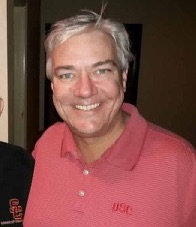Musings from Arledge: USC football finally looks like USC football again

It took long enough. But USC football finally looks like USC football again.
When Lincoln Riley was hired, USC fans were thrilled; not only had USC landed one of the top young coaches in the game but his hiring seemed to answer the question that many had been asking: does USC even care about football anymore? Paying Riley a small fortune seemed to prove that USC still does.
Yes, we had questions. Things like, what’s wrong with Sooners fans? And, will Lincoln Riley’s teams will ever play defense? But Riley was such a dramatic step up from Faith, Family, Futility that we had reason to rejoice.
We also knew it might take time. USC’s program was a mess, its roster put together by Rachel Phelps so she could move the program to Florida. People told Patlynn Swaden they were daft to build a football program on a swamp with Clay Helton in charge, but they built it all the same, just to show ‘em. And it burned down, fell over, then sank into the swamp. That was the status of the USC football program when Mike Bohn made his phone call to Norman, Oklahoma. One day, Lincoln, all this will be yours.
You just have to rebuild it. No easy task.
Still, most of us expected a quicker turnaround. Our fears about Riley’s defensive acumen proved well founded, Grinchian schemes often put players in the worst-possible position, and the Grinch himself seemed sure that the key to defensive success was lots of defensive linemen who were two sizes too small. I know there’s another Hercules Mata’afa here, he cried, we just have to keep losing weight until we find him! USC football became some strange episode of the Biggest Loser only it wasn’t the contestants crying in this version. It was me.
Meanwhile, USC—for probably the first time ever—found itself at a major disadvantage recruiting against other programs, including at least one west-coast program. The Trojans were like a start-up tech company trying to out-recruit Microsoft for the best software engineers if Microsoft was offering huge stock-option plans and the start-up could offer nothing but unpaid internships. And it went about as well as you’d expect.
But no more.
USC is now hitting on all cylinders. The Trojans have the best front-office staff in the country, well-funded coffers, an elite defensive staff full of exceptional recruiters, a state-of-the-art football facility on the way, and—oh yeah—it still has the most proven offensive coach in college football.
On that last point, we can quibble and complain about Lincoln Riley. I’m not giving up my right to do so! I wish he’d run the ball more. I wish he’d show better clock management. But I also know that nobody in college football has his track record of putting great offenses on the field. And now that USC is recruiting like Pete Carroll’s USC, and now that Riley has shown a deep commitment to defensive football with his coaching hires and the allocation of NIL money, USC is in a very good spot.
USC won’t win a national championship this year. There are still holes on the roster that will keep USC from competing at that level. But this team is likely to be much better than the last two years, and the schedule is manageable. USC won’t reach the promised land this year, but you can see it from here. A playoff berth isn’t completely out of the question.
That’s bad news for the programs that feast when USC is flailing. Fans of those programs tend to overestimate their position in college football. We’re a blue blood now! We’re like Ohio State and Georgia! I’m a real boy!
No, you’re not. And you won’t be. Your rich uncle might have bought you a ticket to the rich guy table for a short time, but everybody there knows you don’t belong. You’re still just Jack Dawson in an ill-fitting suit smirking at the titans of industry while the rest of the table is waiting for you to be sent back to steerage. I’ve seen this story, and it won’t end well for you.
So hop up, Oregon, you’re sitting in USC’s chair. Can’t you see it? There go the Ducks, ashamed and angry but too scared to do anything but stand there and bleed as Coach Henny grabs them by the ear and throws them out of the blue-blood room just like Kurt Russell tossing Billy Bob Thornton onto the streets of Tombstone.
Go ahead, Oregon. You skin that smokewagon and see what happens.
Sorry. I’m getting carried away with the movie analogies now.
USC football is finally on the right track. The program has the right staff, the right funding, and—as always—when USC has its act together, good things happen in the Coliseum. Go ahead and be excited, Trojans. We’re about to go on a nice run.
College sports have changed dramatically now that players can make money. The universities and the NCAA are trying to keep up without losing control over the money flow. If you get sued enough, you might eventually be willing to write a check. But the universities still want a salary cap if they can get it, and they’re trying to get it through the House class-action settlement.
The major conferences have rightly concluded that it makes no sense for UCLA and UC Davis to play by the same rules. The major programs are playing one of the most popular professional sports in the country. The hundreds of smaller programs are playing a different game. The old rules no longer make sense.
This shift hasn’t been great. We’ve lost some great traditions. The scene is chaotic. But some of the arguments being made about the future of college football are nonsensical.
Cody Campbell, a former football player at Texas Tech, argues in The Federalist that the big four conferences “are ready to rip [college sports] apart. They’ll tell you it’s about fairness for athletes and ‘stabilization’ of the system. Don’t buy it. It’s a heist, and the victims are the kids you don’t see on ESPN: the gymnast flipping on a worn mat, the wrestler grinding for a D-II shot, the swimmer making laps in the pool at 5 a.m. every day.” What is the heist, exactly? “Here’s the economic reality: Football and men’s basketball haul in over 93 percent of the cash — billions that keep swimming, softball, and wrestling alive. Women’s sports and Olympic sports don’t turn a profit. They never will. But they are the heart and soul of the college sports system, pumping opportunity to kids who’d otherwise be sidelined.”
So, according to Campbell, we must keep in place a system that takes huge sums of money from the football and (to a lesser extent) basketball programs in order to keep the non-revenue sports going. “Over-allocate the cash to pay football and basketball stars and/or exclude many institutions from profit streams and media exposure, and universities will swing the axe on the sports that can’t pay their own bills. Non-revenue sports, Olympic sports, women’s sports? Gone. Dreams? Buried.”
That sounds terrible. It’s even worse than you think. Campbell can see the poor victims, and their pain is immense. “If the money gets siphoned off, it’s not just the NCAA that bleeds — it’s Mia, the 14-year-old gymnast with Olympic fire in her eyes, and Jake, the wrestler pinning his future on a scholarship.” Not Mia! Not Jake!
Campbell, an avowed free-marked advocate, is standing athwart college-football history, yelling Stop! Here’s what he says we face if the NCAA can’t continue to cap football and basketball earnings of players to fund non-revenue sports:
“The top 40 most-viewed college football programs already hog 89.3 percent of TV eyeballs and 95 percent of media cash. Give the Autonomy Four (especially the Big 10 and SEC) a free antitrust hall pass, and they’ll build a super conference, a gilded monopoly that starves everyone else of the revenue needed to provide opportunity to more than 500,000 student athletes per year. Of 134 FBS schools, 90 or more could lose funding for Olympic sports, women’s teams, and even football itself (not to mention the FCS and Division II). Local towns could crumble. Smaller colleges would fade. College sports would shrink from a national treasure to an elite clique, and countless dreams would be crushed.
This isn’t about left or right; it’s about right and wrong. The NCAA is broken, but handing the keys to a few fat cats is worse. America thrives on competition, not cozy cartels blessed by D.C.”
Almost everything about Campbell’s analysis is wrong.
His starting point is just weird: the top 40 programs “hog” all the “TV eyeballs.” Sure. And the Beatles, Stones, and Michael Jackson “hogged” record sales. That’s another way of saying that the market has its preferences. People buy what they like, and people watch what they like. You’d think a free-market advocate would get that.
And I’m not quite sure what towns will crumble if there are cuts to non-revenue sports. By definition, those sports aren’t generating much in the way of money for anybody. Factories don’t shut down if the field hocket team gets put on ice. I assume Campbell visited Eugene recently. But that’s just what Eugene looks like. It didn’t crumble because the wrestling team disappeared.
And most importantly, Campbell’s conclusion that schools can fund non-revenue sports only by capping football players’ pay is simply false. It’s not true that schools can’t provide other sports without being able to cap the players’ pay by keeping the bulk of football revenue. That’s just how the big schools choose to fund the non-revenue sports.
But that’s not the way it works at the vast majority of colleges and universities. Many smaller schools fund sports even though every program loses money. And schools have an incentive to do so. Just as schools have been in an arms race over the last few decades to build better dorms, better food service, better entertainment and workout spaces, schools still have an incentive to offer sports teams. Stanford recruits a lot of very good students from fancy neighborhoods for their non-revenue sports. Stanford can still afford to field those teams and draw those students without taking money that should be paid to its football players. If the little colleges with tiny endowments can do it, I’m quite sure Stanford, Vanderbilt, and Notre Dame can.
My choices coming out of high school were to go to a more-prestigious university or a smaller, liberals arts school where putting a 5’8” 180 pound, modestly athletic defensive back on the field would not be ridiculous. (Some may still have thought it ridiculous.) Larry Smith’s tenure was not going as USC fans had hoped, but Larry had not yet resorted to recruiting guys like me. So if I wanted to play football, I needed to go somewhere where people were foolish enough to give me a roster spot.
Top 10
- 1Breaking
Quinn Ewers drafted
Texas QB off the board
- 2
Dick Vitale
Bold Shedeur Sanders prediction
- 3Trending
Mel Kiper
Eviscerates NFL: 'Clueless'
- 4Hot
Costly fall in NFL Draft
How much plummet costs Shedeur Sanders
- 5
Prank Callers revealed
Video of Shedeur Sanders prank callers
Get the On3 Top 10 to your inbox every morning
By clicking "Subscribe to Newsletter", I agree to On3's Privacy Notice, Terms, and use of my personal information described therein.
It worked out well for both parties. I got to play football, and the college got a very good student who would not have attended that college if the football program did not exist. That dynamic still exists for small colleges all over the country.
We didn’t have to worry about people taking all of that excess football revenue to fund non-revenue sports at William Jewell; all of our teams lost money, football more than anybody. We played in a high-school sized stadium (not Texas high schools; Connecticut high schools, maybe) for high-school sized crowds. Sometimes, when we were struggling, it was even worse: UCLA-sized home crowds. Under the circumstances, I didn’t believe we were entitled to fancy road trips and expensive swag. I expected steerage accommodations.
And our trappings almost met my expectations.
My freshman year I played on the baseball team, too. I figured, like the athlete I was most often compared to, Bo Jackson, that it would be criminal not to give as many fans as possible the opportunity to see my athletic genius. So how could I, in good conscience, play only football?
My freshman year our baseball team took an early season road trip through the south, driving all the way from Liberty, Missouri to Jacksonville, Florida, playing games along the way. Jacksonville was our last stop and the highlight of the trip. Our opponent was, I believe, the defending national champions. We were excited. We broke out the new uniforms for that one. They were sweet; a light gray, modern style, far superior to the antiquated light-blue uniforms we wore that were patterned off those monstrosities that the St. Louis Cardinals had in the 70’s or 80’s or whenever hard drugs were in fashion.
There was only one problem: we could only afford 25 uniforms, and there were 26 players on that trip. Well, make that two problems, because our coach insisted on wearing one of the 25. Granted, that is baseball tradition—though quite possibly the most ridiculous of baseball traditions. Why must the coach be in uniform!? Bill Belichick didn’t wear shoulder pads and a helmet on the sidelines; Phil Jackson didn’t coach Kobe and Michael wearing shorts and a tank top; Bela Karolyi didn’t coach Nadia wearing a matching leotard. Just absurd.
So 26 players; 24 uniforms; you can do the math. (Unless you’re a Duck fan. Then you should ask whoever is helping you read this.) And you can probably already identify one of the two players without a uniform.
I figured that was a pretty good sign that I wasn’t going to play that day. I wasn’t troubled. If I wasn’t going to play, I didn’t need to dress out. My coach disagreed. I said okay, I would wear my practice gray pants and a warmup jacket. That I could blend in. My coach disagreed. I had to wear the light blues while all of my teammates (except one poor bastard) were in grays, and, yes, I did have to take pregame infield with the team just so everybody could see the fashion show.
One of the fans asked a teammate why two guys were in special uniforms. Are they All-Americans or something? Not exactly, he replied drily. In this case, blue didn’t beat gray—a dream come true for those Southerners, I suspect—and one teammate and I were simply ritualistically humiliated for reasons that I still don’t comprehend. Therapy hasn’t helped.
We had about as much food money as uniform money. We ate McDonald’s most meals. We were limited to four dollars per meal, per player. (Coach would shout a friendly reminder: Four bucks, fellas!) In case you were wondering, a value meal in 1992 cost more than four dollars.
That’s what it’s like to play small-college sports, at least it was in 1992 if you had a lunatic as a head coach.
Oh yeah, let me answer the question I asked at the beginning of this section. How could I, in good conscience, only play football? I got the answer later. A few weeks after baseball season ended I was walking through the athletic complex and passed the baseball coach. He greeted me: “Hey, Miker!” My name, of course, is not Mike; not now and not then, either. After playing a full season on his team—I was the guy in blue! How can you not remember me?!—the coach still thought my name might be Mike (Mike Arhedge, I’m assuming—yes, it’s that coach), and he thought that a great nickname for Mike Arhedge would be Miker. That was my last season of baseball.
Now I’m not saying major universities’ non-revenue sports should have mismatched uniforms and live on Oliver Twist rations. I’m also not saying they can’t; I survived it so I’m not sweating it. I am saying that non-revenue sports don’t have to travel cross country a dozen times a year, nor do they need to eat like the football players eat. I’m also saying that major universities have the means to feed, uniform, and schedule the non-revenue sports, in style if they want to, even without putting an artificial salary cap on football players’ earnings to fund it. Stanford and USC can pay for the field hockey team without reaching into the star quarterback’s pocket. And if that means the schools want the non-revenue sports to cut their budgets a little, that’s not unfair. The house band doesn’t travel the way Beyoncé does. Life isn’t always fair, but that’s fair.
If William Jewell College and hundreds of other colleges can fund non-revenue sports without having pulling tens of millions of dollars from football revenues, the much bigger and richer universities in the major conferences sure can.
There is one legitimate issue that requires some action, either by Congress or the NCAA. Players should not be receiving fake NIL from outsiders. Legitimate NIL deals are fine. Professional athletes (and that’s what these guys are) often get endorsement deals. But fake NIL from third parties doesn’t make sense for anybody. If supporters want to donate money to the university or university-related collectives, I have no problem with schools passing that money along to the players. It’s pay for play but it’s going through the university.
And that last part is critical. Having outsiders determine the payroll of a school’s roster is a bad thing. It’s bad for the team, which doesn’t have control over their recruiting efforts or rosters. Imagine losing the star quarterback before game seven because some guy over whom the program has no control decided not to pay the promised “NIL.”
Such a system is also bad for the players, who may be dealing with unscrupulous actors who renege on deals or pressure unsophisticated kids to sign unconscionable contracts. Imagine a kid signing away his endorsement rights for the next 20 years in exchange for $10,000 in a confusing contract where the high school student had no real representation. That’s all bad.
If the contracts are with the schools or school-controlled collectives, all of this can be policed. If it’s not, it can’t be. So go ahead, Uncle Phil, and write a giant check. If that gives your alma mater an unfair advantage, so be it. They certainly need one. But pay it through the school, and we can hold the schools accountable for what happens.

